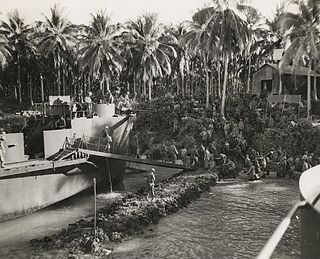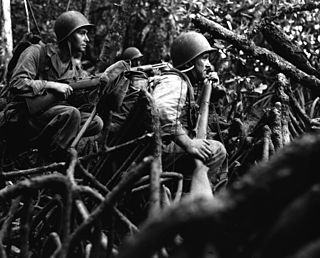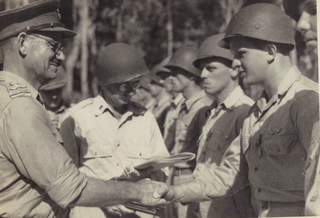
The New Zealand Expeditionary Force (NZEF) was the title of the military forces sent from New Zealand to fight alongside other British Empire and Dominion troops during World War I (1914–1918) and World War II (1939–1945). Ultimately, the NZEF of World War I became known as the First New Zealand Expeditionary Force. The NZEF of World War II was known as the Second New Zealand Expeditionary Force (2NZEF).

USS Talbot (DD-114) was a Wickes-class destroyer in the United States Navy during World War I and later designated APD-7 in World War II. She was the first ship named in honor of Silas Talbot.

The New Georgia campaign was a series of land and naval battles of the Pacific campaign of World War II between Allied forces and the Empire of Japan. It was part of Operation Cartwheel, the Allied strategy in the South Pacific to isolate the Japanese base around Rabaul. The campaign took place in the New Georgia group of islands, in the central Solomon Islands and followed the Allied capture of the Russell Islands. The main fighting took place on New Georgia island itself, although significant actions also took place around the island chain throughout the campaign.

The 3rd New Zealand Division was a division of the New Zealand Military Forces. Formed in 1942, it saw action against the Japanese in the Pacific Ocean Areas during the Second World War. The division saw action in the Solomon Islands campaign during 1943–1944, during which it undertook landings on Vella Lavella, the Treasury Islands and the Green Islands. Due to manpower shortages, for most of its existence the division consisted of only two infantry brigades in addition to support personnel, with its third brigade being disbanded shortly after formation. In 1944, manpower shortages in the New Zealand economy became acute led to the disbandment of the division. The majority of its manpower was returned to civilian employment, although around 4,000 men were sent to Italy to reinforce the 2nd Division, seeing further action before the end of the war in May 1945.

The Battle of the Treasury Islands was a Second World War battle that took place between 27 October and 12 November 1943 on the Treasury Islands group, part of the Solomon Islands. The battle formed part of the wider Pacific War and involved New Zealand and US forces fighting against Japanese troops. The majority of the ground forces were provided by the New Zealand 3rd Division.

The Battle of the Green Islands or Operation Squarepeg was fought from 15 to 20 February 1944, between Imperial Japan and Allied forces from the New Zealand 3rd Division and the United States. Undertaken after landings to secure lodgments on New Britain and Bougainville, the main focus of the operation was the capture of Nissan Island, which was secured by New Zealand forces after only a short ground campaign. At only very limited cost in terms of casualties, the Allied operation resulted in the capture of several small atolls in the island chain, which were subsequently used to support air and naval operations focused on reducing the main Japanese base on Rabaul.

The Battle of Vella Lavella was fought from 15 August – 6 October 1943 between Japan and the Allied forces from New Zealand and the United States at the end of the New Georgia campaign. Vella Lavella, an island located in the Solomon Islands, had been occupied by Japanese forces early during the war in the Pacific. Following the fighting around Munda Point, the Allies recaptured the island in late 1943, following a decision to bypass a large concentration of Japanese troops on the island of Kolombangara.

The Landings at Cape Torokina, also known as Operation Cherryblossom, took place at the beginning of the Bougainville campaign in World War II. The amphibious landings were carried out by elements of the United States Marine Corps in November 1943 on Bougainville Island in the South Pacific, as part of Allied efforts to advance towards the main Japanese base around Rabaul under Operation Cartwheel. Coming in the wake of Allied successes at Guadalcanal and in the central Solomons, the landings were intended to secure a beachhead with the purpose of establishing several bases from which to project air and naval power closer towards Rabaul, in an effort to neutralize the large Japanese force that had been established there.

Major General Sir Harold Eric Barrowclough & Bar, was a New Zealand military leader, lawyer and Chief Justice from 1953 to 1966.
The 36th Battalion was an infantry battalion of the New Zealand Military Forces, which served during the Second World War. Attached to the 8th Brigade, New Zealand 3rd Division, the battalion was formed in late 1941 and saw service in the Pacific against the Japanese. They were initially used for garrison duties on Fiji and Norfolk Island before being committed to the fighting in the Solomon Islands in 1943. The battalion was disbanded in late 1944 as part of a partial demobilisation of New Zealand forces, which saw some of its personnel being returned to civilian employment while others were sent to Italy as reinforcements for the New Zealand 2nd Division.

The 8th Brigade was a formation of the New Zealand Military Forces, which served during the Second World War as part of the 2nd New Zealand Expeditionary Force. Eventually forming part of the 3rd Division, the brigade served in the Pacific Ocean theatre of the war. Raised in late 1940, initially the brigade was employed on garrison duties on Fiji before returning to New Zealand in mid-1942. In December 1942, it was sent to New Caledonia where they remained until early September 1943, when they moved to Guadalcanal to prepare for operations in the Solomon Islands. The brigade's only combat operation of the war came in October–November 1943, when it captured the Treasury Islands. It was disbanded in late 1944 due to manpower shortages in the New Zealand economy.
Major General Owen Herbert Mead, was an officer in the New Zealand Military Forces who served during the First and Second World Wars.
The 29th Battalion was an infantry battalion of the New Zealand 3rd Division, raised for service during the Second World War. Serving in the Pacific, the battalion mainly undertook garrison duties and labouring tasks in Fiji and New Caledonia, but saw brief combat against the Japanese in the Treasury Islands in late 1943. In late 1944, the battalion returned to New Zealand and was broken up to provide reinforcements for the New Zealand 2nd Division in Italy. It was eventually disbanded in January 1945.

The 14th Brigade was a formation of the New Zealand Military Forces, which served during the Second World War as part of the 2nd New Zealand Expeditionary Force. Eventually forming part of the 3rd Division, the brigade served in the Pacific Ocean theatre of the war. Raised in December 1941, the brigade undertook garrison duties in Fiji before being relieved by US troops in mid-1942. After this, it took part in two combat actions against Japanese forces in 1943–1944: the Land Battle of Vella Lavella and the Battle of the Green Islands. In mid-1944, the brigade was broken up to return manpower to New Zealand industry and to meet the reinforcement needs of the 2nd Division in Italy.
The 30th Battalion was an infantry battalion of the New Zealand 3rd Division, raised for service during the Second World War. After being raised in late 1940, the battalion undertook garrison duties in Fiji and on New Caledonia during the early part of the war, before undertaking combat operations during the latter part of the Solomon Islands campaign, landing on Vella Lavella and the Green Islands in 1943–1944. The battalion was disbanded in mid-1944 to return manpower to the New Zealand economy and to provide reinforcements to the New Zealand 2nd Division, which was fighting in Italy.
The 37th Battalion was an infantry battalion of the New Zealand Military Forces, which served during the Second World War. Attached to the 14th Brigade, New Zealand 3rd Division, the battalion was formed in late 1941 and saw service in the Pacific against the Japanese. They were initially used for garrison duties on Fiji and New Caledonia before being committed to the fighting in the Solomon Islands in 1943. Returned to New Zealand in late 1944, the battalion was disbanded in early 1945 as part of a partial demobilisation of New Zealand forces. Many of its personnel returned to civilian employment while others were sent to Italy as reinforcements for the New Zealand 2nd Division. The battalion was awarded four battle honours for its various engagements during the war.
Major General Sir William Henry Cunningham was an officer in the New Zealand Military Forces who served during the First and Second World Wars.
The 34th Battalion was an infantry battalion of the New Zealand Military Forces, which served during the Second World War. Formed in Fiji in late 1940, it saw service in the Pacific against the Japanese.
Brigadier Robert Amos Row, was a senior officer in the New Zealand Military Forces and a two-time recipient of the Distinguished Service Order. He served in the New Zealand Expeditionary Force during the First World War, commanding an infantry battalion. In the Second World War, he commanded the 8th Brigade during the Battle of the Treasury Islands.

The Battle of Arundel Island was fought from 27 August – 21 September 1943, primarily between United States Army and Imperial Japanese Army forces on Arundel Island during the New Georgia campaign in the Pacific War. The battle took place towards the end of the campaign after the capture of Munda airfield and mopping up operations in western New Georgia had resulted in the Japanese evacuation of mainland New Georgia. The US high command decided to occupy the island so that it could be used as a base for artillery to fire on the main Japanese troop concentration on Kolombangara.












